
EVENTS
- Home
- EVENTS
MAJOR EVENTS IN THE SEYCHELLES (CHRONOLOGICAL ORDER)
-
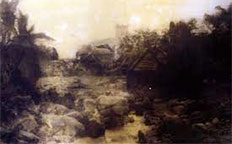
GREAT AVALASSE
A storm generated an avalanche, consisting of mudflow mixing rocks, mud, vegetation and trees. Localisation of the mudflow was mainly eastern slopes of the mountain over Port Victoria, Police and Prison yards, Victoria street, Royal Street, Anglican Church, Cluny Orphanage, old cemetery, and Government House. all bridges in Victoria destroyed, all roads severely damaged, houses destroyed, coconut trees blew down, a number of boats sunk, with at least of 70 victims.
12 October 1862 -
STORM ON MAHÈ
2 persons injured
January 1975 -
SEVERE FLOODS/ LANDSLIDES
Severe floods on the 3 main islands, and slide at St. Louis, more that 1 million SCR damages. On Mahé, 3 persons dead.
31st August–1st September 1985 -
CYCLONE IKONJO
Cyclone Ikonjo hits Desroches island—USD 1,500,000 damages, 2 injured in Mahé
17–23 May 1990 -
LANDSLIDES
Landslides 3 dead in Praslin, 1 in MahéJanuary–April 1992 -
ENSO (RECURRING CLIMATE PATTERN INVOLVING CHANGES IN THE TEMPERATURE OF WATERS)
Floods, landslides The ENSO rainfall event—USD 1,700,000 damages, 5 persons dead in Mahé.
12–17 August 1997 -
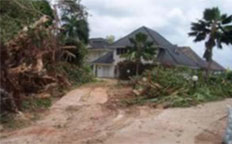
TROPICAL DEPRESSION ‘01S’ STORM
Damage on Mahé was limited to landslides and some flooding. On Praslin, high winds damaged the roofs of houses and destroyed homes, while the airport was also damaged. The winds damaged power lines, causing an island-wide power outage.
06–07 September 2002 -
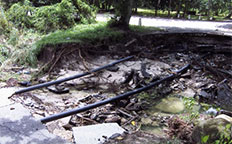
THE GREAT INDIAN OCEAN TSUNAMI
There were 2 deaths in Seychelles. The damage to coastal infrastructure on both eastern and western shores was most severe where natural coasts had been modified. Damage to public works was greatest in Victoria. Dock structures were damaged in Port Victoria. Washouts and eventual collapse occurred on two bridges of the highway between Victoria and the airport, and coastal roads were damaged in a number of other places. The fisheries sector was the hardest hit as many fishing vessels and equipment were damaged or lost. In some places, homes were flooded and some incurred minor structural damage.
December 2004 -
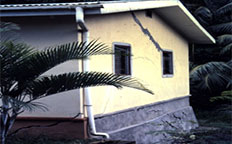
VISTA DO MAR LANDSLIDE
The Vista Do Mar Estate in the north of Mahé, is being affected by a deep-seated landslide. Sustained heavy rainfall of about 170 mm/day over a two-day period increased the pore pressure enough to cause accelerated movement and damage to property). The slope is presently in an actively unstable stage and moves whenever triggering factors are active. Numerous houses were affected.
December 2004 And Early January 2005 -
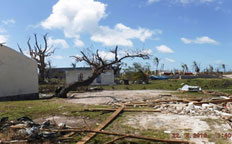
CYCLONE BONDO STORM
The storm affected Providence and Farqhuar islands. The majority of the Farquhar Atoll residents were evacuated. Bondo destroyed most of the buildings and about 60 percent of the coconut trees on Providence, decimating the island’s copra industry. Rough seas caused flooding, beach erosion, and coastal damage on Mahé, Praslin, and La Digue. One person was injured on Mahé.
December 2006 -
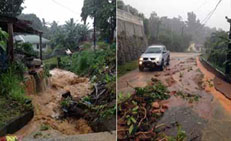
TROPICAL CYCLONE FELLENG
The storm caused severe flooding and landslides in three districts on the southeast coast of Mahé (Au Cap, Pointe Larue, and Cascade), as well as on the nearby islands of Praslin and La Digue. The rainfall overwhelmed existing natural and constructed drainage systems and retaining walls, causing floods, landslides, and rockfalls, and resulting in serious damage to homes and public buildings, roads, bridges, drainage systems, water and sanitation systems, crops, and farms.
27–28, JANUARY, 2013 -
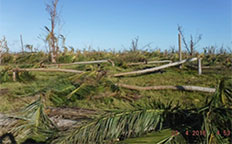
TROPICAL CYCLONE FANTALA
The storm damaged infrastructure in the Farquhar Atoll, the archipelago’s outer island. The storm made landfall with winds up to 350 km/h. The effects were estimated at SCR 101 million.
2016 -
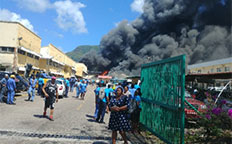
SPTC FIRE
The Seychelles Public Transport Company store located at Latanier Road at the SPTC New Port Depot caught fire at around 1300 hours. Following the fire, a Presidential Order was given to assess the risks in Victoria. The main aim of the assessment was to identify hazardous activities and their related risks.
8 August, 2018 -
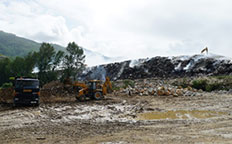
LAND FILL FIRE
This was not the first time for a fire to take place at the Land Fill at the Providence Industrial Estate, but it was the most significant. The response operations were officially active for 6 days; the 19th to the 25th September 2020. By 25th September, the Emergency Response tactical strategies were scaled down but a high level of alert and surveillance was maintained during the following week.19-25 SEPTEMBER, 2020 -
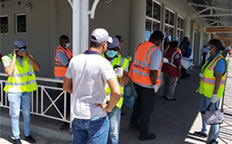
GLOBAL PANDEMIC
The DRDM took the initial lead in the coordination efforts with the health authorities to empower their officers to navigate the pandemic, firstly by setting up the Public Health Emergency Operation Centre (PHEOC), and secondly by providing technical support to health personnel by DRDM’s in-house World Health Organisation (WHO) certified trainers. By the time the first case of COVID-19 was detected locally, protocols and resources were in place to respond to the situation.2020 – Ongoing -

RECORD BREAKING RAINFALL
The torrential rain led to widespread flooding concentrated mainly in the Northern region of Mahé namely Bel Ombre, Beau Vallon, Glacis and St. Louis districts. The downpour led to overflowing rivers, embankments collapse, mass flooding, road blockage, power outage and many slope failures affecting many households and businesses. Other regions of Mahé were also affected with flooding.
A total of 4 deaths were recorded along with 3 missing people cases. 350 people were sheltered and 90 households were affected.
The recorded rainfall on the 6th December 2023 was the highest rainfall recorded within 24hours and the highest rainfall recorded within a month in Seychelles.
6th December 2023 -

CCCL EXPLOSION
At exactly 2:15AM a container containing dynamites exploded at Civil Construction Company Ltd (CCCL), Petite Paris, Cascade. The explosion caused significant structural damage to the Providence industrial estate and the residential homes located in the nearby districts mainly Cascade. The shockwave of the explosion reached as far as the Seychelles International Airport, Point Larue and the Bel Ombre district.
A total of 345 buildings were partially damaged or fully destroyed in the industrial estate, with more than 600 businesses affected. Whereas 621 people were affected and 178 injured in the residential districts. Around 400 houses were structurally damaged or destroyed and 202 people was relocated for shelter.
In Bel Ombre, 13 hotels, 9 travel operators, boat charters and restaurants reported to have experienced the disruption. The explosion also caused several power outages in the affected areas. The incident was declared as a National Emergency by the President as the affected residents were evacuated to temporary shelters.
7th December 2023
Weather Forecast
Contact Us
- Global Village, Suite no 3, Mont Fleuri, Mahe.
P.O. Box 113, Victoria, Mahe, Seychelles - +248 4389898
- info@drmd.sc
